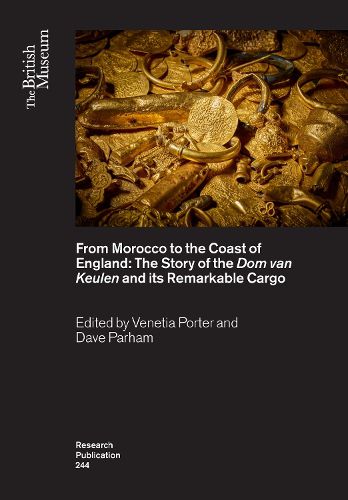Readings Newsletter
Become a Readings Member to make your shopping experience even easier.
Sign in or sign up for free!
You’re not far away from qualifying for FREE standard shipping within Australia
You’ve qualified for FREE standard shipping within Australia
The cart is loading…






In 1994, the remains of a 17th-century shipwreck were discovered by divers off Salcombe Bay. The finds consisted of 400 gold coins of the Sa'dian sharifs of Morocco in addition to ingots, jewellery as well as other items including Dutch pewter and pottery - the majority of which are now in the British Museum collection. Although the ship does not survive in its entirety, divers discovered remnants of wood, rope and lead that were parts of its infrastructure. This finds from this shipwreck are significant for several reasons: the gold is clearly a bullion hoard and the number of Sa'dian coins offer great insight into the numismatic history of the period. In addition, such pieces of 16th?17th century Moroccan jewellery from this period rarely survive in datable contexts. Alongside these gold objects are objects which provide a fascinating insight into everyday life on board ship, including crockery, sea sickness pills, beans and copper coins.
Whilst there was much debate at the time of discovery about the origin and identity of the ship, it became clear from analysis of the objects that a Dutch origin was most likely. Research undertaken for this publication has revealed the likely identity of the ship - the Dom van Keulen, a Dutch trading ship which is reported to have sunk off the coast of Salcombe in 1633. This book therefore not only offers a detailed record of the find and the objects recovered, but also provides tangible evidence of a flourishing maritime trade in the 17th century, connecting Morocco, the Low Countries and Britain.
$9.00 standard shipping within Australia
FREE standard shipping within Australia for orders over $100.00
Express & International shipping calculated at checkout
Stock availability can be subject to change without notice. We recommend calling the shop or contacting our online team to check availability of low stock items. Please see our Shopping Online page for more details.
In 1994, the remains of a 17th-century shipwreck were discovered by divers off Salcombe Bay. The finds consisted of 400 gold coins of the Sa'dian sharifs of Morocco in addition to ingots, jewellery as well as other items including Dutch pewter and pottery - the majority of which are now in the British Museum collection. Although the ship does not survive in its entirety, divers discovered remnants of wood, rope and lead that were parts of its infrastructure. This finds from this shipwreck are significant for several reasons: the gold is clearly a bullion hoard and the number of Sa'dian coins offer great insight into the numismatic history of the period. In addition, such pieces of 16th?17th century Moroccan jewellery from this period rarely survive in datable contexts. Alongside these gold objects are objects which provide a fascinating insight into everyday life on board ship, including crockery, sea sickness pills, beans and copper coins.
Whilst there was much debate at the time of discovery about the origin and identity of the ship, it became clear from analysis of the objects that a Dutch origin was most likely. Research undertaken for this publication has revealed the likely identity of the ship - the Dom van Keulen, a Dutch trading ship which is reported to have sunk off the coast of Salcombe in 1633. This book therefore not only offers a detailed record of the find and the objects recovered, but also provides tangible evidence of a flourishing maritime trade in the 17th century, connecting Morocco, the Low Countries and Britain.